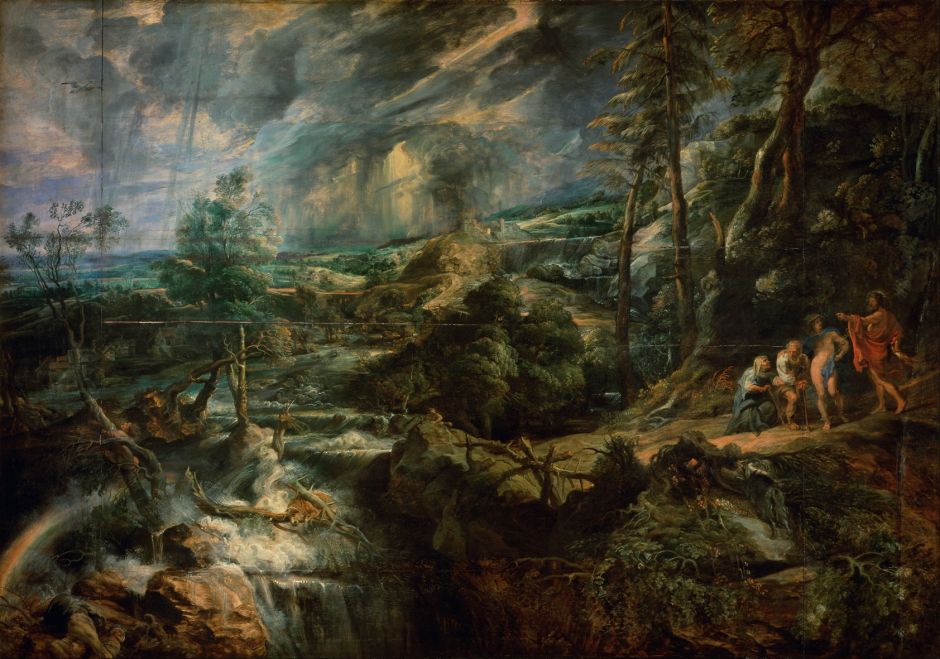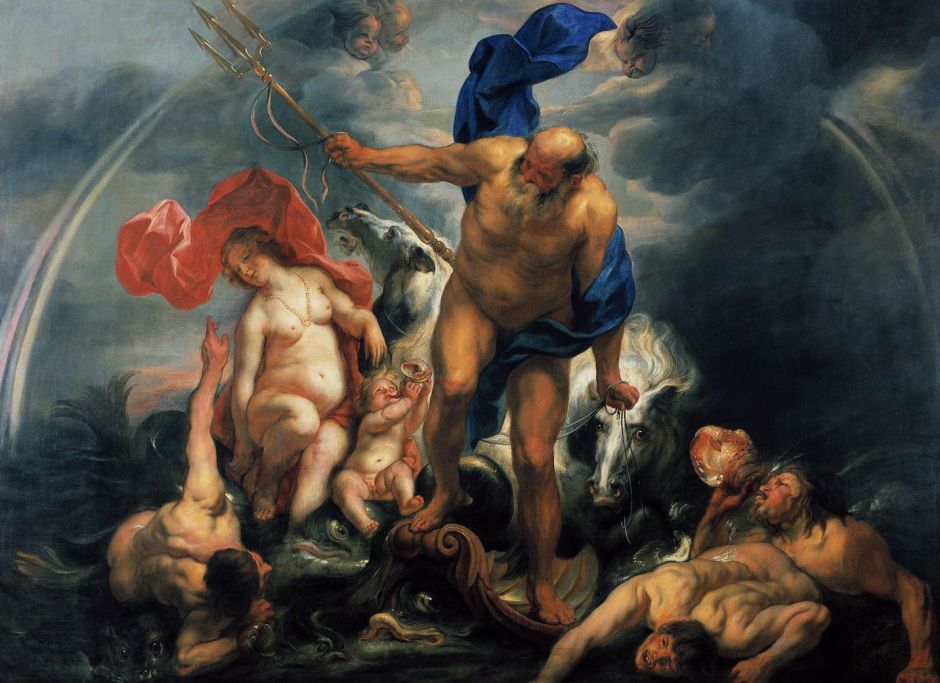Rainbows are among the most beautiful and ephemeral of atmospheric optical effects, and haven’t escaped the attention of painters. In this and the next article I look at their reading in two genres, today in narrative works, and tomorrow in landscapes.
In the ancient civilisations living around the Mediterranean, rainbows became associate with deities.

Antonio Palomino’s Allegory of Air from about 1700 shows the goddess Iris to the right, pointing to her rainbow, with Hera/Juno sat in her chariot drawn by a pair of peacocks. Both goddesses are making the sign of the bow using their contrastingly coloured garments.

Guy Head’s Iris Carrying the Water of the River Styx to Olympus for the Gods to Swear By from about 1793 is a good example of the goddess in her role of cup-bearer to the Olympian deities. Iris was one of the few allowed to come and go not just to the River Styx to fetch its water, but to enter the Underworld when transferring dead heroes.

George Hayter’s Venus, Supported by Iris, Complaining to Mars is a later account of this scene from Homer’s Iliad, which was exhibited to acclaim at the Royal Academy in 1820, and three years later won the Academy’s award for Painting of the Year. Iris is behind with her iridescent wings, helping Aphrodite towards a reclining Ares.

Rubens’ Stormy Landscape with Philemon and Baucis (c 1625) is one of the few paintings to show a broader view of later moments in Ovid’s account of this myth. His dramatic landscape shows storm clouds building over the hills, a raging torrent pouring down the mountainside, dragging large trees and animals in its swollen waters, and the four figures on a track at the right. Philemon and Baucis are struggling up the track with their sticks, as Jupiter points to a rainbow formed over a waterfall at the lower left corner.

Jacob Jordaens’ Neptune and Amphitrite in the Storm from 1644 includes Amphitrite, Poseidon’s wife and the Queen of the Seas. As one of the daughters of Nereus and Doris, she is a Nereid. When she sings to Poseidon her voice calms his raging storms and brings peace to the waters, and here is associated with the rainbow that might follow a squall.
A rainbow also has a prominent role in Norse and Finnish mythology.

Hans Thoma’s painting of The Trek of the Gods to Valhalla (1880) shows the group of gods known as the Æsir riding across the bridge Bifröst, which is formed from a burning rainbow to reach from Midgard, realm of humans, to Asgard, realm of the gods. The Æsir traditionally include Odin, Frigg, Thor, Baldr, and Týr. Recognisable on the bridge are Odin, holding his staff, with Frigg, and Thor with his hammer. At the left is probably Iðunn, holding an apple of her youth aloft. This is another event foretold as part of the process of Ragnarök.

Ekman’s Väinämöinen Playing (1857-66) refers to Songs 40-41 of the Finnish Kalevala. When Väinämöinen is on his way with Ilmarinen to Pohjola to get the Sampo, they catch a huge pike, kill and eat it. Väinämöinen makes a kantele (Finnish harp) from its jaws, but no one else knows how to play it. Väinämöinen plays it so beautifully that all creatures make their way to listen to him playing, and all weep with emotion. Väinämöinen’s own tears fall into the water, where they become blue pearls.
The rainbow that’s most familiar to Europeans today is that following the great flood. When Noah gave thanks to God for being spared, God made a covenant with him and the survivors never to repeat such destruction of mankind, and that’s signified in the rainbow.

Domenico Morelli captures this in his undated Noah’s Thanksgiving after Leaving the Ark.
The rainbow reappears in the Last Judgement, as described in the book of Revelation.

Crispin van den Broeck’s painted vision of The Last Judgment dates from the sixteenth century. It’s hard to tell whether the unnatural order of colours in its rainbow is the result of changes in pigments.
For an unknown reason, William Blake decided to paint colours in his rainbows in reverse order of those in nature, after he had seen George Romney’s painting of Newton and the Prism (1794).

Blake’s Four and Twenty Elders Casting their Crowns before the Divine Throne from about 1803–5 follows the text from Revelation:
And immediately I was in the spirit: and, behold, a throne was set in heaven, and one sat on the throne. And he that sat was to look upon like a jasper and a sardine stone: and there was a rainbow round about the throne, in sight like unto an emerald. And round about the throne were four and twenty seats: and upon the seats I saw four and twenty elders sitting, clothed in white raiment; and they had on their heads crowns of gold.

At about the same time, he added a rainbow with its colours in the correct order to his watercolour of The Death of the Virgin (1803).
Rainbows are also to be found in Christian religious paintings that lack a scriptural basis.

In Evelyn De Morgan’s Angel Piping to the Souls in Hell from 1916, a winged angel flies above whorls of heads. The angel holds a golden pipe to their mouth, and plays it. The heads below are shown in an ethereal rainbow tube, which swirls around the mountainous background. Most of the faces are distorted in unpleasant emotion, as flames lick around the coils of the tube. She painted this in the middle of the First World War as an expression of her deep spiritual distress at the time.

In Léon Frédéric’s polyptych All Things Die, But All Will Be Resurrected through God’s Love, painted over the period 1893-1918, three panels at the right represent Heaven, a pastoral landscape densely packed with a multitude of naked mothers and children. A similar pair of women in priestly clothing stand at the wings. The figure on the right is holding a stone tablet on which a single word appears: LEX (law), and near her children are playing with the scales of justice. Near the woman at the left two children are swinging censers which generate the smoke of burning incense. Above them all is a double rainbow, and floating in the air the figure of Christ, his arms reaching out over still more figures of children, this time clothed in white robes.

